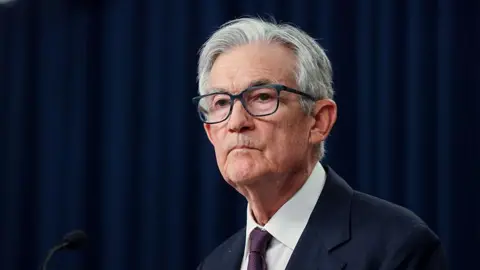The article titled “Fed holds rates because of tariff ‘uncertainty'” explores how the United States Federal Reserve has chosen to maintain its current interest rates amid the complexities brought about by President Donald Trump’s tariff policies. The decision, announced recently by the Fed, marks their third consecutive meeting without altering the key lending rate, which remains at approximately 4.3%. This particular stance comes despite pressures from President Trump, who has expressed a desire for reduced borrowing costs to stimulate economic activity.
Federal Reserve Chair Jerome Powell responded to the current economic uncertainty brought on by tariffs, stating that it is “not at all clear” what actions they should take next. This uncertainty has added significant complexity to the Fed’s policy-making process, especially as the economic landscape continues to fluctuate in response to international trade tensions. Powell emphasized that the tariffs imposed by Trump have significant implications, potentially leading to increased inflation, slower economic growth, and rising unemployment.
Typically, the Fed adjusts interest rates based on economic performance metrics. It tends to lower rates to bolster a struggling economy or increase them to control rising prices. However, the current situation is unprecedented; the tariffs have introduced risks of both a hampered economy and spiraled inflation. The Fed, designed to operate independently of White House pressures, must navigate these risks carefully as they formulate future policy directions.
The article delves into the backdrop of the decision made by the Fed, highlighting the substantial impacts of tariffs that started to ramp up last month. Trump’s tariffs, particularly the 145% tariffs on imports from China, have already initiated a noticeable decrease in trade activity reported by logistics firms and ports across the United States. In light of these developments, analysts have warned of an increased risk of recession, especially since the macroeconomic indicators have become distorted by companies hastily importing goods before tariffs took effect.
Additionally, the article mentions Trump’s past promises to pursue lower interest rates, which adds another layer of political pressure as interventions from the White House could potentially lead to instability within the financial sector. His interactions with the Federal Reserve, including critical remarks aimed at Powell, underscore the tense relationship between the administration and the central bank, especially as Trump voices frustrations about the pace of interest rate changes.
Furthermore, the article anticipates upcoming trade discussions between U.S. officials and their Chinese counterparts. While the potential outcomes of these negotiations could be significant, Trump has already declined to consider reducing tariff rates preemptively to facilitate the dialogue. This indicates a hesitance to alter his trade policies amidst tariff-related complexities, despite Powell suggesting that the talks could materially influence the country’s economic trajectory.
The Fed’s decision arrives at a time when the U.S. economy had contracted in the first quarter of the year for the first time since 2022. Nevertheless, Federal officials argue that the shrinking economy is largely due to temporary factors, such as businesses rushing imports, rather than an indication of declining overall economic health. Notably, employment figures have remained robust, sustaining a low unemployment rate of around 4.2%.
In summary, the Federal Reserve’s decision to hold interest rates steady occurs amid considerable tariff-induced uncertainty, presenting challenges to policymakers. Jerome Powell’s caution reflects broader economic dynamics influenced by international trade policies, with serious implications for growth and employment. As the situation evolves, all eyes will be on how the Fed navigates this tumultuous landscape and the corresponding effects on both domestic and global economic health.



